L2: Development of theory of mind
1/66
There's no tags or description
Looks like no tags are added yet.
Name | Mastery | Learn | Test | Matching | Spaced |
|---|
No study sessions yet.
67 Terms
what is the overall definition of Theory of mind?
the ability to understand what other people might be thinking.
- The knowledge that other people hold mental states and these govern their behaviour. beliefs, desires, gaols.
- allow us to predict and explain peoples actions in the social world.
what is Desire-based ToM
What does somebody else want?
- these desires may change depending on many factors. do children understand that other people have desires different to theirs?
What were the findings from Repacholi & Gopnik, 1997? on desire based ToM.
18 month olds but not 14 month old understood that the experimenters desires were different to theirs (broccoli preference over crackers) "can you give me what i like"
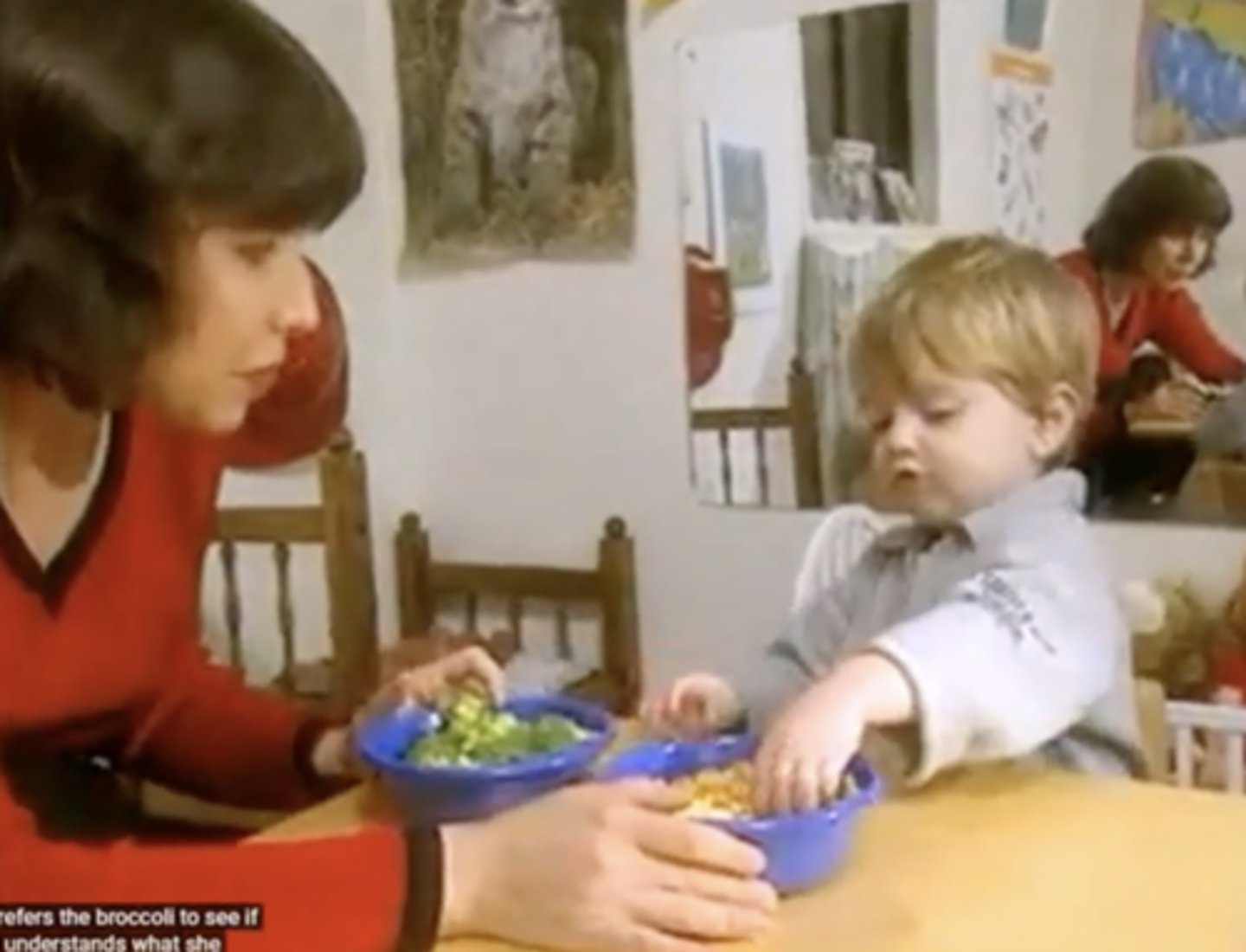
what must therefore happen to the child between 14 month and 18 months old (Repacholi & Gopnik, 1997)
Children becomes aware that desire is a subjective mental state that can differ from person to person.
- is this stage like or a gradual change?
what is belief-based ToM?
there is a distinction between what we believe and the world as it is.
- reality is inherently subjective.
- your representation of the world is different from others representation. therefore have to shift from a situation based to a representation based understanding of behaviour.
what task can we use to can we tell whether a child has a ToM?
The false belief task
what does the false belief task test?
whether a child can represent what another person believes in contrast to their own beliefs or reality.
what does the unexpected transfer task show? Wimmer & Perner, 1983
Whether the child understands that where they know the chocolate is (fridge) will be different to where maxi will think the chocolate is (in the cupboard). Can children think in Maxi's perspective and put aside their own?
'where will Maxi look for his chocolate?'
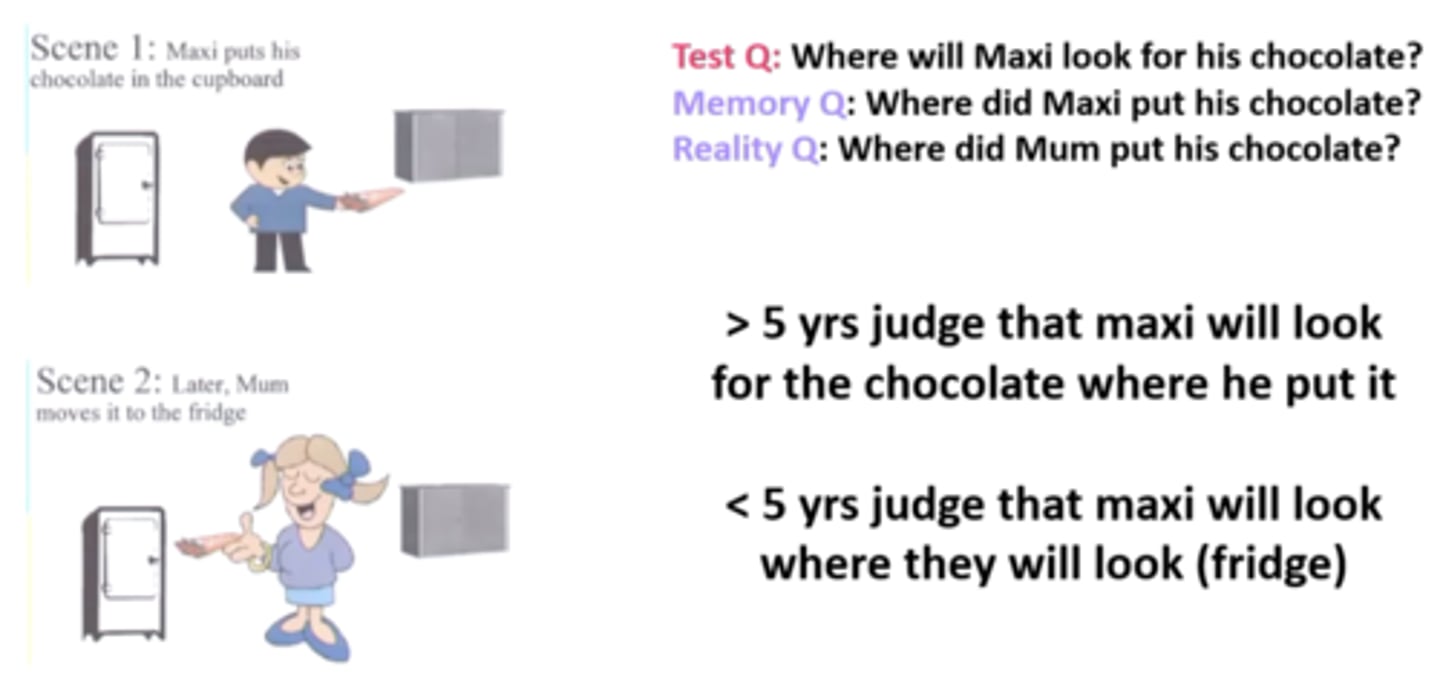
What age range understood Maxi's false belief? Wimmer & Perner, 1983
Children greater than 5 (on average around 4/5 this is when ToM develops)
What age range judged that maxi would look for the chocolate in the fridge (where they know it is)
children less than 5
what is a true belief task?
Tests whether a child can represent what another person believes when that belief matches their own beliefs/reality (maxi sees mum put chocolate in fridge so no FB)
- belief matches reality so no discrepancy.
How old are the children who fail the Sally Ann task?
42 months (52 months pass)
who developed the unexpected transfer task (maxi)
Wimmer & Perner, 1983
who developed the Sally-Ann task?
Baron-Cohen, Leslie & Frith, 1985
what does failure (42 months) and success (52 months) of the Sally-Ann task suggest? Baron-Cohen, Leslie & Frith, 1985
if child says that Sally would look in the box - they have developed a ToM as they understand that sally did not see Ann move the block from the box into the basket. change between age 3 and 4 where ToM is seen to have developed
what happens in the deceptive box task? Perner et al (19870
the child knows that smarties are not actually in the smarties tub but have to predict what their friend will say is inside the box.
what was found from the deceptive box task?
3 year olds - pencils
4 and 5 - friends will think smarties are inside the box
how did Gopnik and Astington (1988) develop the deceptive box test.
added question - 'before you opened tube what did you think was inside?'
- 3-4 were not good at acknowledging that they had previously believed that smarties were in the box. but there are individual differences
at what age is there though to be a radical conceptual shift for ToM?
around 4 years old. 3y/o tend to fail FB tasks
4 year old tend to pass
why may it be that 3 year olds do have a ToM
lack of evidence doesn't mean lack of competence. problem with language/skills to express belief. the way the question is worded?
what was found when the test question for the unexpected transfer task was simplified? : 'Where will maxi look first of all? ' (siegal & Beattie, 1991)
simplifying the task improves performance but not dramatically (35-71%) but still a gap identified.
Wellman, Cross & Watson (2001) meta-analysis of 178 studies
support for substantial developmental eFfect between 3.5 and 4 years old over preschool years.
What variable did Wellman et al 2001 find did not impact whether the child displayed ToM?
The type of task/question given/object in question
what variable did Wellman et al 2001 find did impact whether the child displayed ToM?
whether there was a deceptive motive (character trying to trick other one) / if kids had more of an active role in the story - tended to see ToM earlier when child takes active role.
what did Wellman et al (2001) conclude?
manipulating several variables improved performance across all ages. didn't seem to unmask early competence as every age group improved when these manipulations were made
- no manipulations improved performance of 3 year olds.
cross-cultural comparisons for ToM (Callaghan et al, 2005)
- 3 y/0 tend to fail
- 5 year old tend to pass
- despite different lives/childhoods, still see developmental shift between 3 and 5 years old.
what do findings from Callaghan et al, 2005 cross-cultural study suggest?
there may be a biological aspect to development that happens to almost all children around this age.
how may role of social experience aid understanding of others mental states?
PRACTICE - being around other people and interacting with adults
- May take 4 years to become good at this
how may biological maturation enable children to express understanding of mental states?
From improvement in executive functioning - rapid neurological development by these ages that allow ToM to develop.
Role of experience - what did Harris (1999) find?
conversations are crucial for exposing children to other people's perspectives/ PRACTICE
- vocab needed to discuss and reflect on mental states/practice this. e.g preschool environment opens up much practice to make shift this possible.
role of experience - older siblings?
children with older siblings tend to develop ToM earlier. Get practice eafrlier as have older people to play with.
role of experience - interaction from parents
Children whose parents talk about mental states more understand FB earlier than other children. constantly talking in dialogue with children
role of experience - deaf children
Deaf children of hearing, non signing parents show a developmental lag on FB tasks (Peterson & Siegel). cant hear what parents are saying and parents don't speak sign language - lack of practice which is important for development.
role of experience - how do deaf children of signing parents vary?
They are comparable with hearing children - not suffering from developmental lag as are able to communicate and practice with parents.
who developed the ToM scale? different sub categories of ToM
Wellman & Liu (2004)
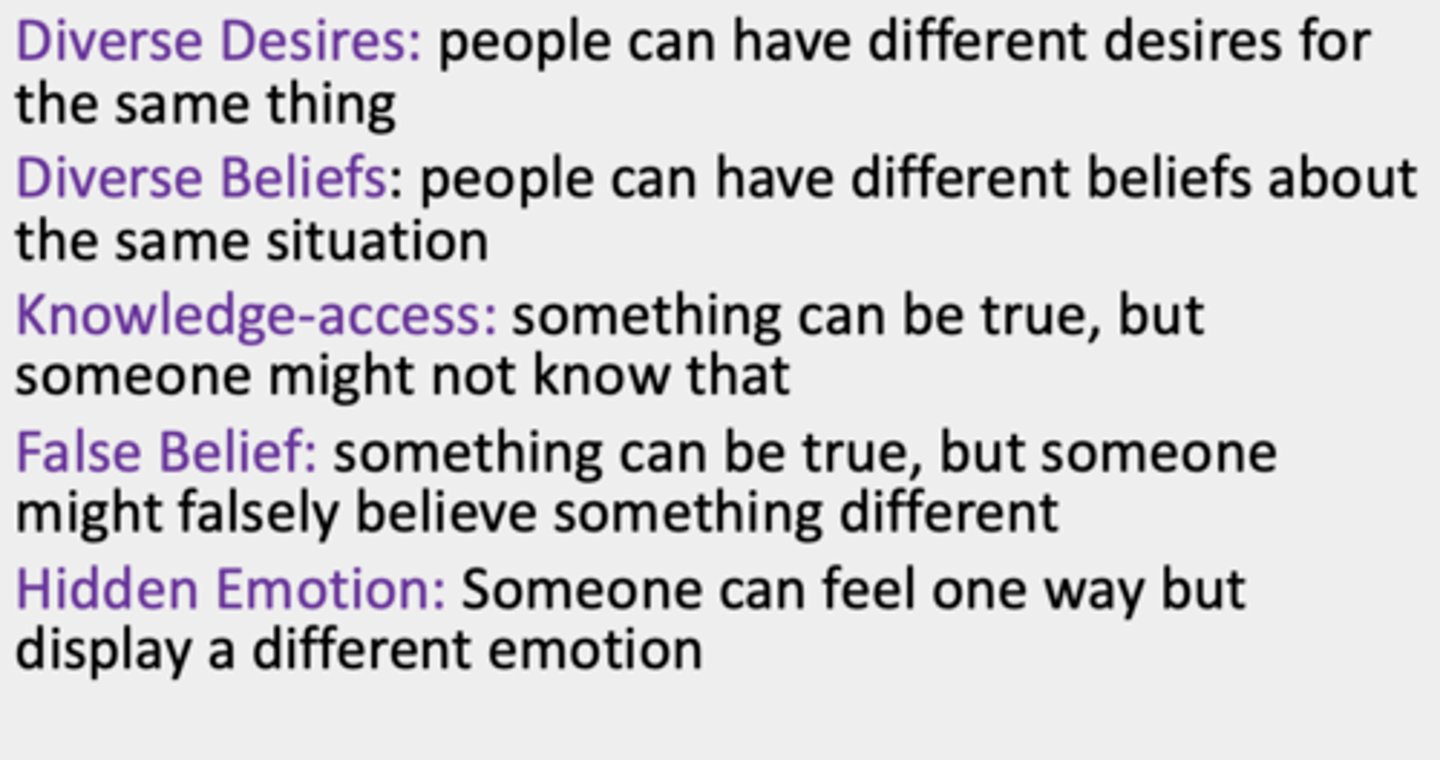
How do the different kinds of subcategories develop in western children?
- Children in western countries follow the pattern of development.

How do the different kinds of subcategories develop in Chinese and Iranian children?
Knowledge access develops before diverse beliefs - understood ToM in terms of knowledge than before different perspectives (Wellman et al 2006)

why may Wellman et al (2006) have found those findings?
- Findings are thought to be related to collectivist/individualistic cultures.
- Many cultures in collectivist societies emphasise harmonies and not disagreeing. explains why Diverse beliefs comes after. Culture you live in does influence the way you learn about other people's beliefs.
what is the main biological influence on ToM?
The role of Executive Functioning
- problems translating conceptual knowledge into successful action.
what is executive functioning?
Cognitive abilities that help to control and guide our attention and behaviour.
where is the central executive located?
in prefrontal cortex (frontal lobes).
- take long time to develop
what are the 3 main abilities executive functioning deals with?
- Inhibition
- cognitive flexibility
- working memory
what is inhibition?
ignoring distracting information/suppressing unwanted responses.
- bear/dragon task
- stroop paradigm.
what is cognitive flexibility?
responding to the same thing in different ways depending on the context
- e.g multiple passwords
- task-switching paradigm.
- Wisconsin card sorting test.
what is working memory?
Holding important information or your 'goal in mind'. Manipulating and holding information in your head that is useful to that moment.
- mental shopping list
- digit span/spatial span
When do the important neurological developments in inhibitory control take place?
within the first 6 years of life, with marked improvement between age 3 and 6 (Diamond & Taylor)
what is the role of executive function/inhibitory control on false belief tasks?
development in inhibitory control and ToM may be related - IC may be a crucial enabling factor for ToM development, possibly affecting both the emergence and expression of mental state knowledge - ability to inhibit own beliefs and put yourself into perspective of someone else.
how did Moll et al (2016) implicitly measure FB in children?
investigated children's facial expressions as indices of their belief understanding
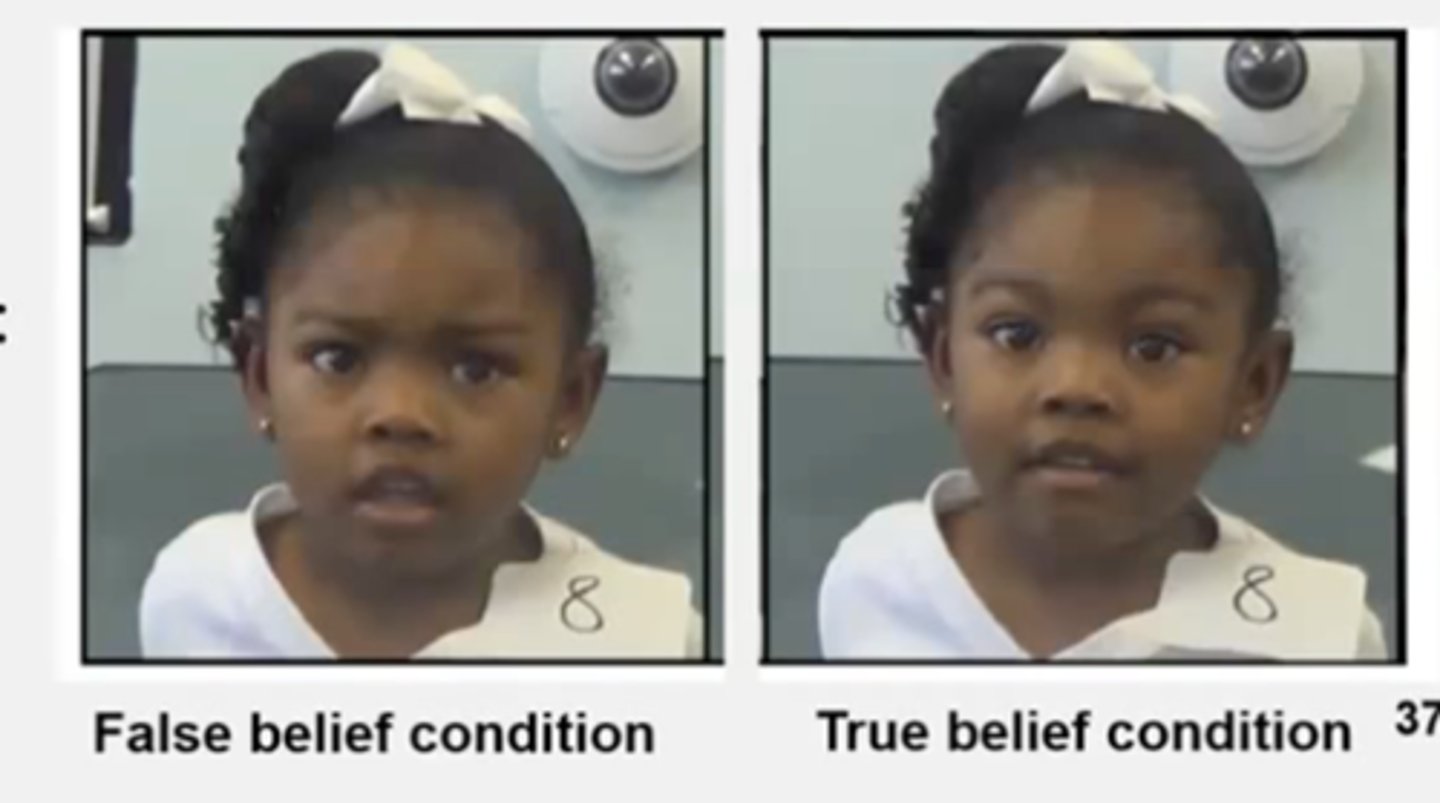
what did Moll et al (2016) predict?
if 3 y/os perceive the conflict between a person's belief and reality, they will show signs of suspense (facial expressions) when observing an actor about to act on the basis of their false belief.
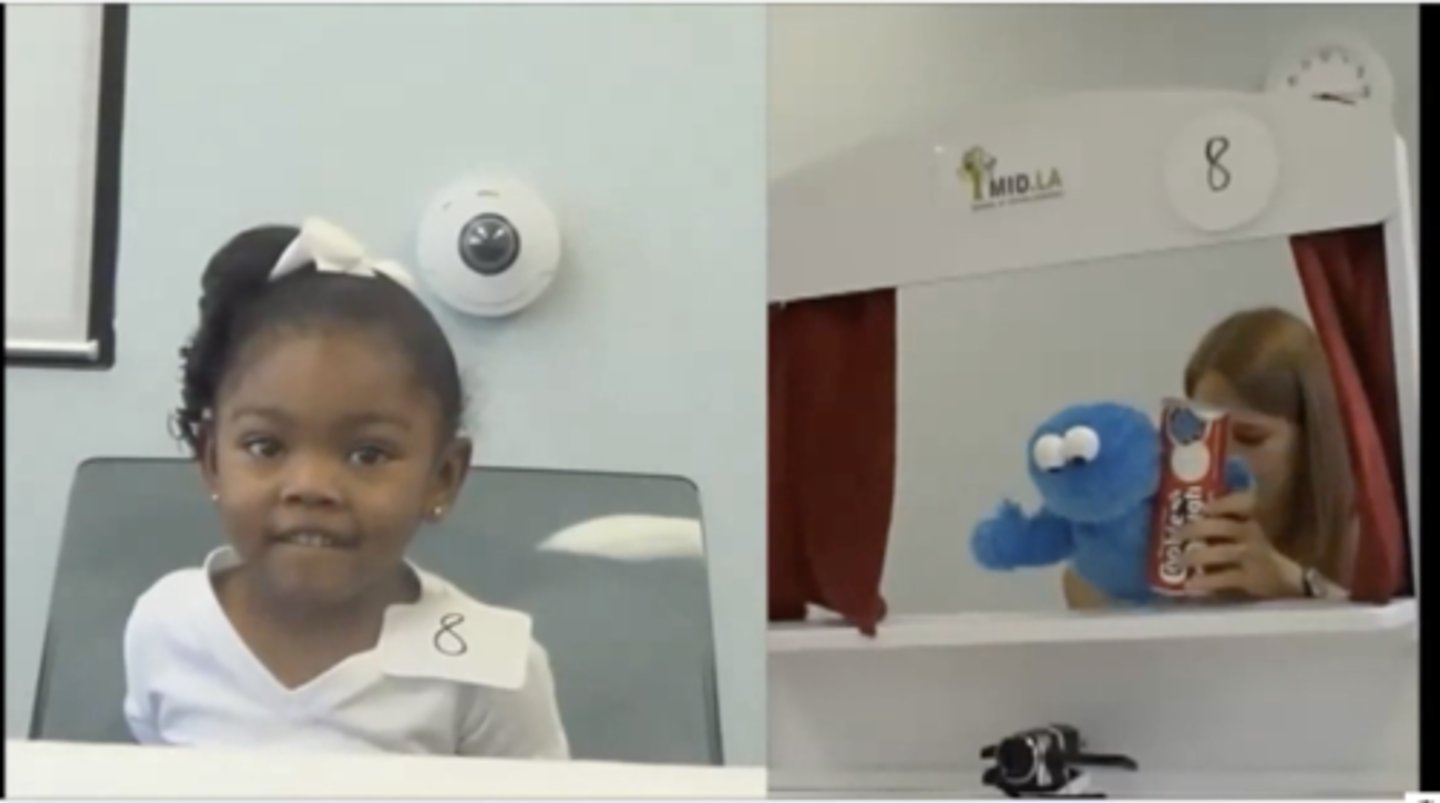
what were the physical signs of suspense? Moll et al (2016)
lip biting and brow furrowing. realises the false belief conflict on actors behalf.
what happened in the true belief condition? Moll et al (2016)
change in facial expression did not occur.
The child did not show any signs of suspense. no distress illustrated.
- no false belief situation
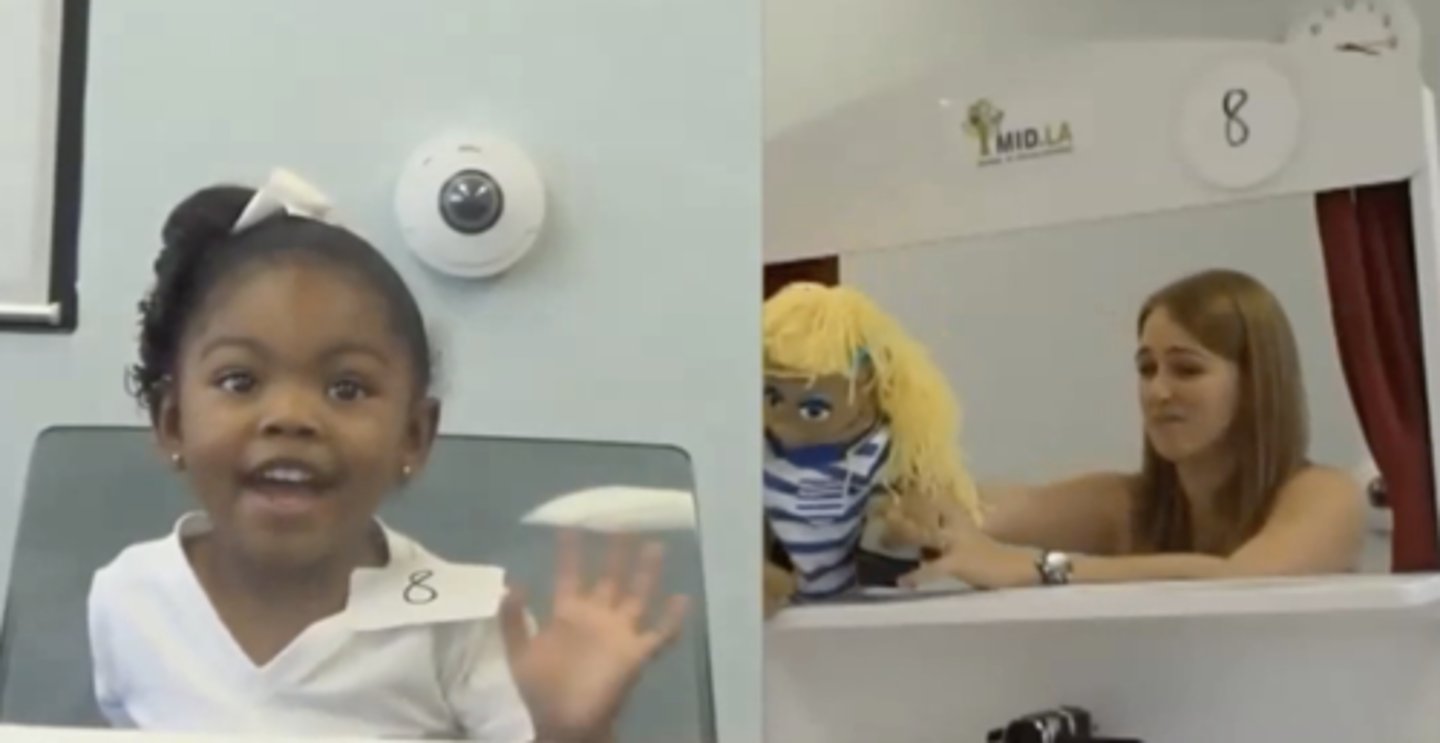
what contrast was found between classic false belief tasks and false belief videos?
When children could not explicitly verbalise their knowledge, there was an unrelated amount of expressions displayed whilst watching videos. (suggesting ToM) suggests that expressions are independent from and emerge prior to explicit knowledge of FB's.
What was the aim of Clements & Perner, 1994 study?
aimed to get evidence for a period of implicit understanding of FB that precedes the onset of explicit understanding.
method of Clements & Perner (1994)
used the anticipatory looking paradigm (implicit) on 44 children aged 2y 5m - 4y 6m.
- how long they spend looking in a certain direction to determine if they correctly anticipate what will happen next. (thats where they will look)
What task did Clements & Perner (1994) use?
unexpected transfer task.
- sam puts cheese in box A and then sleeps
Katie moves cheese from Box A to B
"i wonder where sam is going to look for his cheese" (record child's eye gaze)
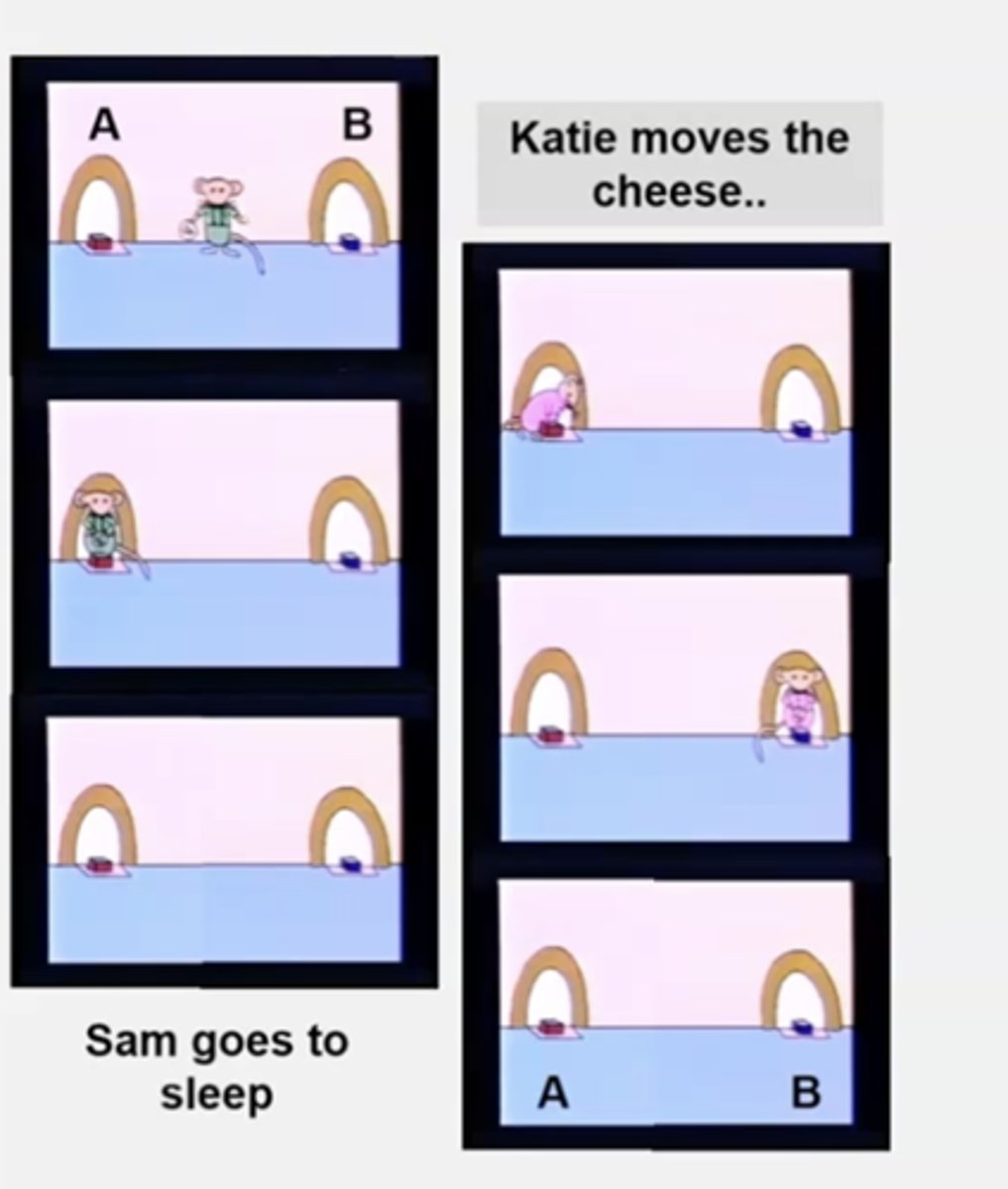
where will children look longer if they understand the false belief? Clements & Perner (1994)
Box A (where sam put the cheese)
results of Clements & Perner (1994)
86% children over 2y 11m showed looking pattern indicative of FB (looked at box A in FB condition) understanding - illustrates a full year before explicit measures define understanding of FB.
how do implicit and explicit measures of FB understanding differ?
For implicit tasks, there is a giant gap - more kids younger who display these FB behaviours whereas for explicit measures its a much more gradual rise.
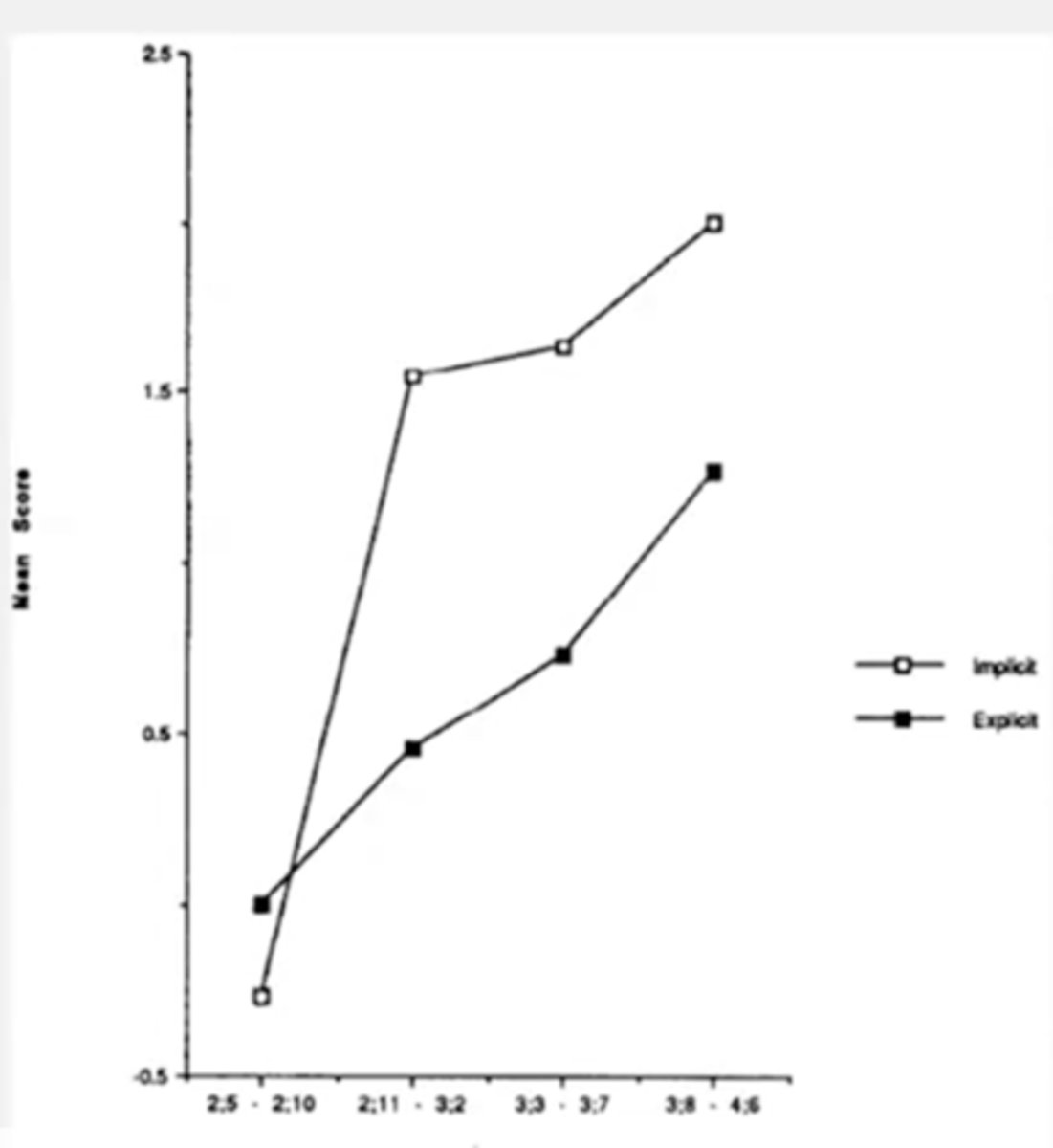
overall findings Clements & Perner (1994)
Children develop an implicit understanding of FB before they are able to explicitly state that they understand what is going on.
what non-verbal method did Onishi & Baillargeon (2005) use to understand FB?
tested for implicit FB understanding in 15 month old infants using violation of expectancy method.
what is the violation of expectation's method?
Familiarise an infant to an event and then present behaviour that is consistent or inconsistent with prior event.
- if infant looks longer at inconsistent event taken as evidence that they are surprised.
what does the violation of expectation's method indicate?
indicates some level of knowledge about what should happen.
Onishi & Baillargeon (2005) task
violation of expectation when experimenter comes back and looks in yellow box where watermelon magically moved to from the green box whilst they were absent...how did they know to look there?
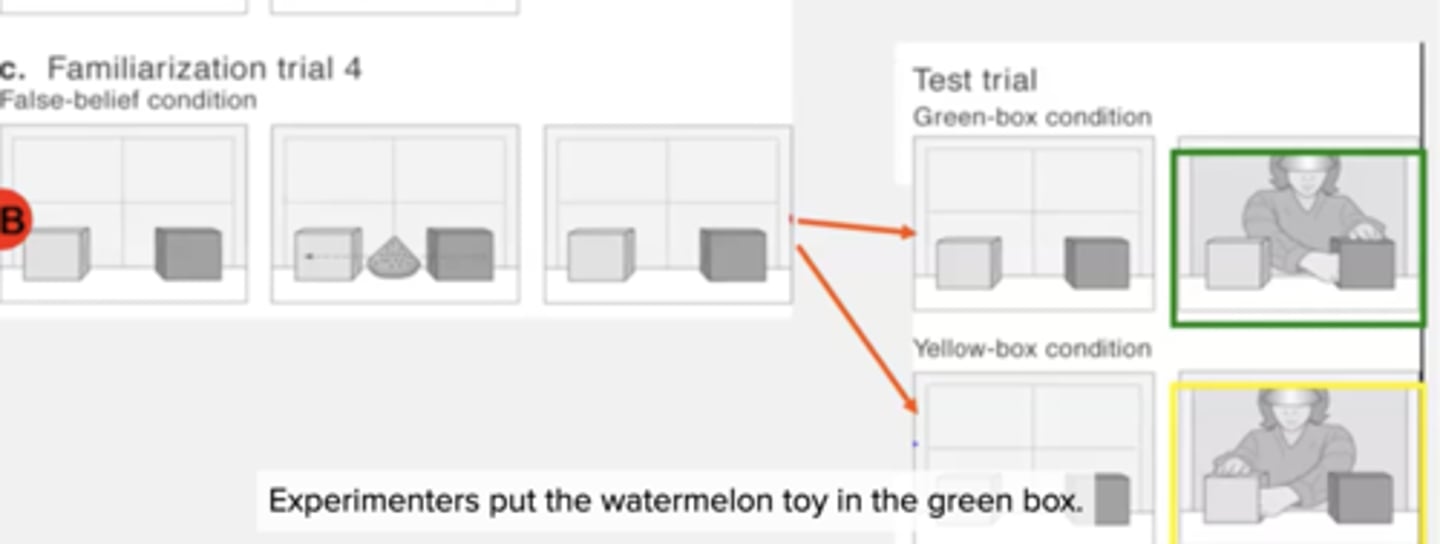
what happened in the true belief condition?
The experimenter watched the watermelon move from the green box to the yellow box but still looks in the green box for it - violating the expectancy of the child as they look longer at the green box.
Onishi & Baillargeon (2005) findings
infants spent more time looking at the yellow box condition when that's where the researcher looked - as this is unexpected (expectation violated). understood that it doesn't make any sense for experimenter to look in yellow box when they believed it was in the green box.
- 15 months old have FB understanding
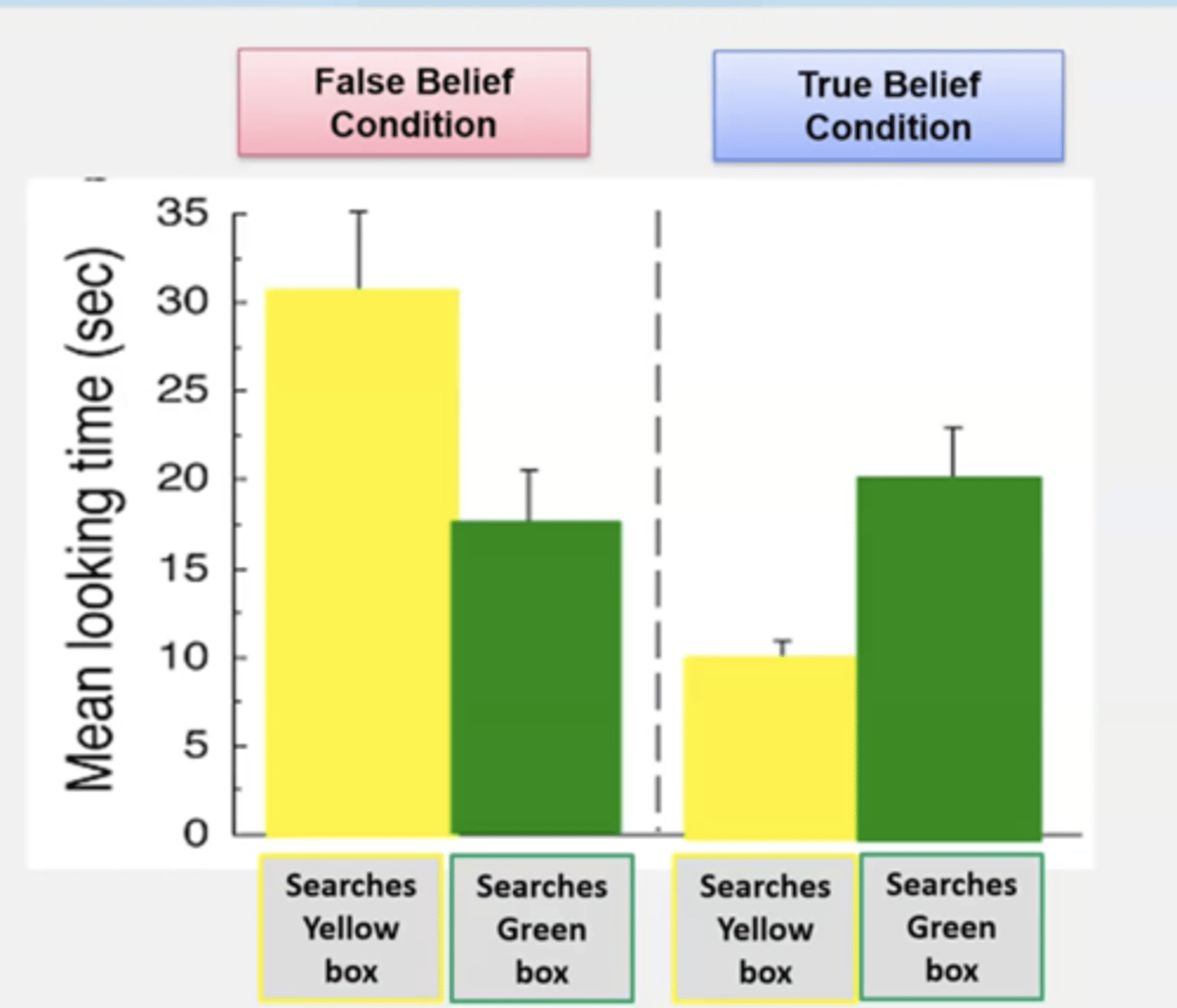
Dual process model - Apperly & Butterfill, 2009
illustrates 2 systems that compute the beliefs of other
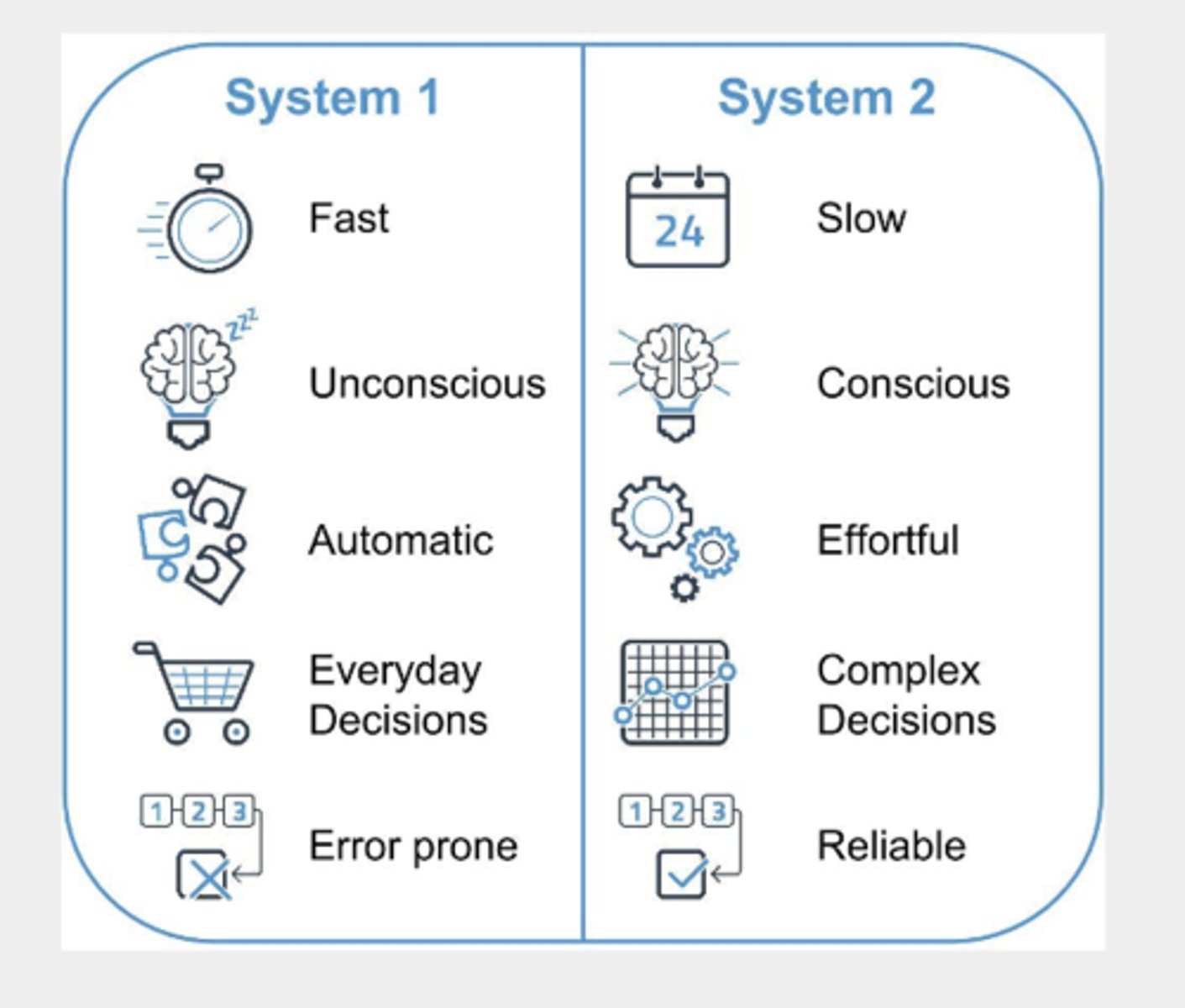
what are the 2 systems in the dual-route/process model? Apperly & Butterfill, 2009
1. fast and efficient system, automatic and unconscious, Supports success in implicit false-belief tasks (e.g. looking-time or anticipatory looking)
2. slow and cognitively demanding system, later developing. explicit, deliberative reasoning about mental states. Around age 4, children begin to develop and engage System 2, allowing them to explicitly reason about beliefs — even when these are different from their own.